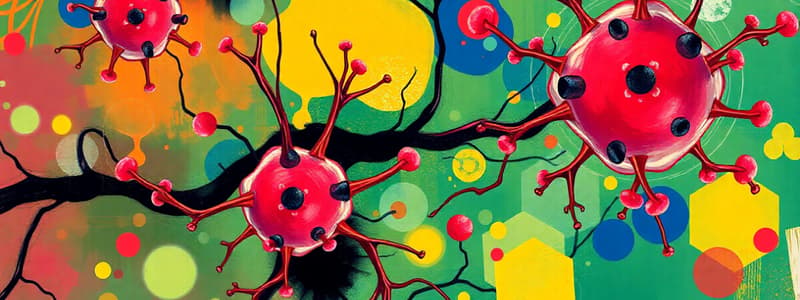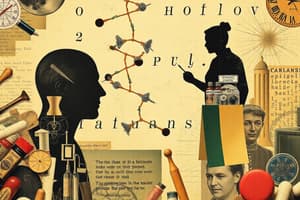Podcast
Questions and Answers
Which factor does not significantly impact drug absorption and distribution?
Which factor does not significantly impact drug absorption and distribution?
- Patient's age
- Route of administration
- Drug's color (correct)
- Digestive system
A lower therapeutic index indicates a safer drug.
A lower therapeutic index indicates a safer drug.
False (B)
What is efficacy in pharmacology?
What is efficacy in pharmacology?
magnitude of the maximal effect a drug can produce
Which of the following best describes pharmacology?
Which of the following best describes pharmacology?
Drug development involves testing to ensure safety and efficacy.
Drug development involves testing to ensure safety and efficacy.
Drugs are classified based on their therapeutic use, chemical structure, or mechanism of ______.
Drugs are classified based on their therapeutic use, chemical structure, or mechanism of ______.
Match the route of drug administration with its characteristic:
Match the route of drug administration with its characteristic:
Name the four main processes involved in pharmacokinetics. Use commas to separate the different processes.
Name the four main processes involved in pharmacokinetics. Use commas to separate the different processes.
Drugs often bind to specific ______ , initiating a cascade of events that lead to a biological response.
Drugs often bind to specific ______ , initiating a cascade of events that lead to a biological response.
What is an example of an ethical consideration in clinical trials?
What is an example of an ethical consideration in clinical trials?
Drug interactions always enhance the effect of one another.
Drug interactions always enhance the effect of one another.
Match the pharmacokinetic process with its description:
Match the pharmacokinetic process with its description:
Where does metabolism mainly occur?
Where does metabolism mainly occur?
What is the dose-response relationship?
What is the dose-response relationship?
Pharmacodynamics describes how the body handles drugs over time.
Pharmacodynamics describes how the body handles drugs over time.
Ideal drugs should exhibit high specificity for their intended target in order to:
Ideal drugs should exhibit high specificity for their intended target in order to:
Flashcards
Pharmacology
Pharmacology
The study of drugs and their effects on living organisms.
Drug Actions
Drug Actions
Drugs interact with targets like receptors and enzymes to exert effects.
Receptor Binding
Receptor Binding
Drugs bind to specific receptors, triggering biological responses.
Enzyme Inhibition
Enzyme Inhibition
Signup and view all the flashcards
Pharmacokinetics
Pharmacokinetics
Signup and view all the flashcards
Absorption
Absorption
Signup and view all the flashcards
Distribution
Distribution
Signup and view all the flashcards
Pharmacodynamics
Pharmacodynamics
Signup and view all the flashcards
Dose-response relationship
Dose-response relationship
Signup and view all the flashcards
Potency
Potency
Signup and view all the flashcards
Efficacy
Efficacy
Signup and view all the flashcards
Drug interactions
Drug interactions
Signup and view all the flashcards
Adverse drug reactions (ADRs)
Adverse drug reactions (ADRs)
Signup and view all the flashcards
Therapeutic index
Therapeutic index
Signup and view all the flashcards
Routes of administration
Routes of administration
Signup and view all the flashcards
Informed consent
Informed consent
Signup and view all the flashcards
Study Notes
Introduction to Pharmacology
- Pharmacology is the study of drugs and their effects on living organisms.
- It encompasses drug discovery, development, mechanisms of action, dosage, and interactions.
- This field is crucial in medicine for treating various diseases and alleviating symptoms.
- It involves an understanding of both the chemical properties of drugs and their physiological effects.
- Drug development is a multi-stage process involving rigorous testing to ensure safety and efficacy.
Drug Actions and Mechanisms
- Drugs exert their effects by interacting with specific targets within the body.
- These targets can include receptors, enzymes, ion channels, and transport proteins.
- Receptor Binding: Drugs often bind to specific receptors, initiating a cascade of events that lead to a biological response.
- Enzyme Inhibition: Some drugs interfere with the activity of enzymes, altering metabolic processes.
- Ion Channel Modulation: Drugs can modulate the activity of ion channels, affecting nerve impulse transmission and muscle contraction.
- Transport Protein Inhibition or Stimulation: Drugs can either inhibit or stimulate transport proteins that facilitate the movement of molecules across cell membranes.
- Drug-Target Specificity: Ideal drugs exhibit high specificity, interacting primarily with their intended target to minimize side effects.
Pharmacokinetics
- Pharmacokinetics describes how the body handles drugs over time.
- This includes absorption, distribution, metabolism, and excretion (ADME).
- Absorption: The process by which a drug is transferred from the site of administration into the bloodstream.
- Factors influencing absorption include route of administration, drug solubility, and the presence of other substances.
- Distribution: The movement of a drug from the bloodstream to various tissues and organs.
- Factors affecting distribution include blood flow, drug binding to plasma proteins, and the blood-brain barrier.
- Metabolism: The process by which the body converts a drug into a less active or inactive form.
- Metabolism mainly occurs in the liver, but other organs can participate.
- Excretion: The elimination of drugs or metabolites from the body.
- Common routes include kidney excretion, bile, and lungs.
Pharmacodynamics
- Pharmacodynamics describes the effects of drugs on the body and the mechanisms by which these effects are produced.
- Dose-response relationship: The relationship between the dose of a drug and the magnitude of its effect.
- This is an essential principle in determining appropriate dosages.
- Potency: The amount of drug needed to produce a specific effect.
- Efficacy: The magnitude of the maximal effect a drug can produce.
- Drug interactions: Several drugs can interact, either enhancing or diminishing the effect of one another.
- This can lead to unexpected outcomes and requires careful consideration.
Drug Classification and Examples
- Drugs are often classified based on their therapeutic use, chemical structure, or mechanism of action.
- Examples include analgesics (pain relievers), antibiotics, anti-inflammatory drugs, and cardiovascular medications.
- Analgesics, such as ibuprofen and aspirin, reduce pain and inflammation.
- Antibiotics, such as penicillin and tetracycline, are used to combat bacterial infections.
Safety and Toxicity
- Drug safety is a critical aspect of pharmacology.
- Thorough pre-clinical and clinical trials are essential to assess potential risks and side effects.
- Adverse drug reactions (ADRs) can range from mild to severe, impacting various organ systems.
- Drug toxicity refers to the harmful effects of a drug at a high dose or due to prolonged exposure.
- Mechanisms of toxicity involve damage to cells or specific tissues.
- The concept of a therapeutic index is important for quantifying the safety margin of a drug: the ratio between the therapeutic dose and the toxic dose. A higher therapeutic index indicates a safer drug.
Drug Administration and Routes
- The route of administration significantly impacts drug absorption and distribution, affecting how quickly and effectively the drug reaches its target.
- Oral administration is the most common route but can be affected by factors like the digestive system.
- Intravenous (IV) administration allows for immediate and precise drug delivery.
- Intramuscular (IM) and subcutaneous (SC) injections are used for depot administration and localized effects.
- Topical application offers localized effects, like creams or ointments for skin conditions.
Ethical Considerations in Pharmacology
- Ethical considerations are paramount in drug development and use to ensure public good and minimize negative consequences.
- Informed consent, patient confidentiality, and safety are crucial components.
- Responsibility of researchers and medical professionals regarding data handling and maintaining accuracy is addressed in clinical trials.
- Regulatory oversight, transparency, and accountability are vital factors in maintaining ethical norms.
Studying That Suits You
Use AI to generate personalized quizzes and flashcards to suit your learning preferences.




